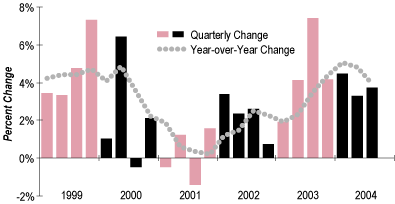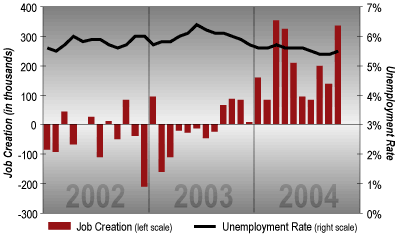The U.S. Economy
Indiana University, Bloomington
The U.S. economy during 2004 brings to mind Charlie Brown, Lucy, and the football. From experience, Charlie knows he should temper his enthusiasm. But the possibility of putting the ball through the uprights seems to be there, and he thinks maybe now is the time. And then Lucy snatches the ball away and Charlie is flat on his back (again).
For the economy, the past several years certainly counsel caution. But as things unfolded in the latter stages of 2003 and the first part of 2004, the possibility of the economy soaring upward on a perfect trajectory into a clear blue sky was hard to resist. More recently, sadly, reality has intervened. To be sure, the Charlie Brown metaphor is not perfect. The economy is not flat on its back by any means. But the dream of perfect trajectory is probably not in the cards, at least not in 2005.
Earlier this year, a broad range of economic indicators were sending out positive signals. By March, output had registered four straight quarters of growth above 4 percent, with the full period over 5 percent. Figure 1 shows the growth rate for real output both quarter by quarter and relative to the same quarter a year earlier. At the sectoral level, the growth of business spending on equipment accelerated over the same period from about zero to well into double-digits, while growth in consumption spending went from below 3 percent to above 4 percent. In the labor market (which tends to lag slightly), employment began to expand in September and increased by an average of 225,000 per month during the first five months of this year. Figure 2 shows employment growth and the unemployment rate. Rising employment is a manifest indication of business optimism. It implies rising income and does wonders for consumer confidence. It seemed that finally the economic football was ready to really take off.
Figure 1
U.S. Real Output: Annual Rate of Change

Figure 2
Monthly Changes to the Labor Market, 2002 to 2004

But as the weather turned warmer, signs that the ball might be snatched away started to appear. The initial problem was the labor market. In June, payroll employment rose only 96,000, and then this disappointing performance was repeated the next month with an increase of only 85,000. The evidence of deceleration was reinforced when second quarter output growth came in at 3.3 percent, more than a full percentage point below the first quarter. Even more troubling, consumption advanced at only a 1.6 percent rate.
Other events over the summer raised more concerns. The Federal Reserve started to push short-term interest rates upward in June and continued to do so in August and September. The situation in Iraq seemed to be worsening. Due partly to this and also to a variety of other concerns, crude oil prices rose dramatically, reaching the fifty-five dollars per barrel level. In nominal terms, this is uncharted territory. High oil prices are in many ways like a large tax on the entire economy. And then during the fall, even the weather turned perverse, especially for Floridians. Faced with all of this, consumer confidence fell in August, and then further in both September and October. Thus, the possibility that the main support under the expansion is a little wobbly cannot be totally dismissed.
All is not bleak, however. While the household sector may be a little shaken, it is not down and out. Consumption spending bounced back in the third quarter of 2004, with growth at an annual rate of 4.6 percent, and business investment in new equipment continues to rise rapidly (up to nearly a 15 percent rate in the third quarter). Partly reflecting this investment, productivity growth remains strong. Higher productivity fuels growth in income and profits.
Looking ahead to 2005, we are guardedly, and apprehensively, optimistic. We think the economy will continue to expand, but probably not quite as strongly as during the past year. Employment will also continue to rise, but again short of 2004 levels. There is a higher than normal amount of uncertainty surrounding the outlook. If a number of things break right, the year could be better than we expect. If they don’t, things could turn out worse than expected. Some details:
- We expect output to grow between 3 and 3.5 percent in 2005. This is less than 2004, but close to the long-run potential of the economy.
- Employment will expand by about 1.5 million. This will mean only a little progress in lowering unemployment.
- Productivity will rise about 1.9 percent, also somewhat below 2004.
- Inflation will remain moderate, although up a little from this year. The consumer price index will increase about 3 percent.
- The Federal Reserve will continue to raise short-term interest rates, by at least 100 basis points during 2005.
We think that the behavior of oil prices will be a key element in the outcome. Our outlook is based on a slightly pessimistic view of the prospects in this regard. We expect crude prices to remain at or above fifty dollars per barrel at least into early 2005, and then to come down some, but only to the vicinity of forty dollars. These relatively high levels produce a significant headwind for the economy through the year.
Policy makers will face a multifaceted dilemma next year. With the economy growing below its potential and unemployment remaining uncomfortably high, stimulus might seem to be in order. But fiscal policy will be seriously constrained by the federal budget deficit (which the president promised to reduce during his re-election campaign). This probably precludes any significant further tax cuts or new spending.
The Fed, meanwhile, seems unlikely to reverse its recent course toward restraint. High oil prices are an element here, since they represent an inflation threat. Another problem for the Fed is the magnitude of our trade deficit, which is now approaching 6 percent of GDP. The economic corrective for the deficit is a depreciation of the dollar. A real problem arises if the depreciation occurs rapidly in a crisis situation. This would raise a very significant danger of seriously higher inflation.
There is no shortage of potential problems in the year ahead. If things go badly in a few crucial regards (for example, deterioration in Iraq, lack of discipline by Congress leading to larger budget deficits, problems in the foreign exchange market, or a further ratcheting up of oil prices), the economy would be unlikely to meet the expectations laid out above. On the other hand, if things break for the better in some of these areas, we could be writing a year from now that 2005 turned out to be a pleasant surprise.
To summarize, we anticipate that the economy will muddle through 2005. The year will be nothing to write home about, but given the potential pitfalls in the current economic landscape, it is far from the worst possible outcome. And if we have some luck, we could muddle through with some style.
Also in this Issue…



